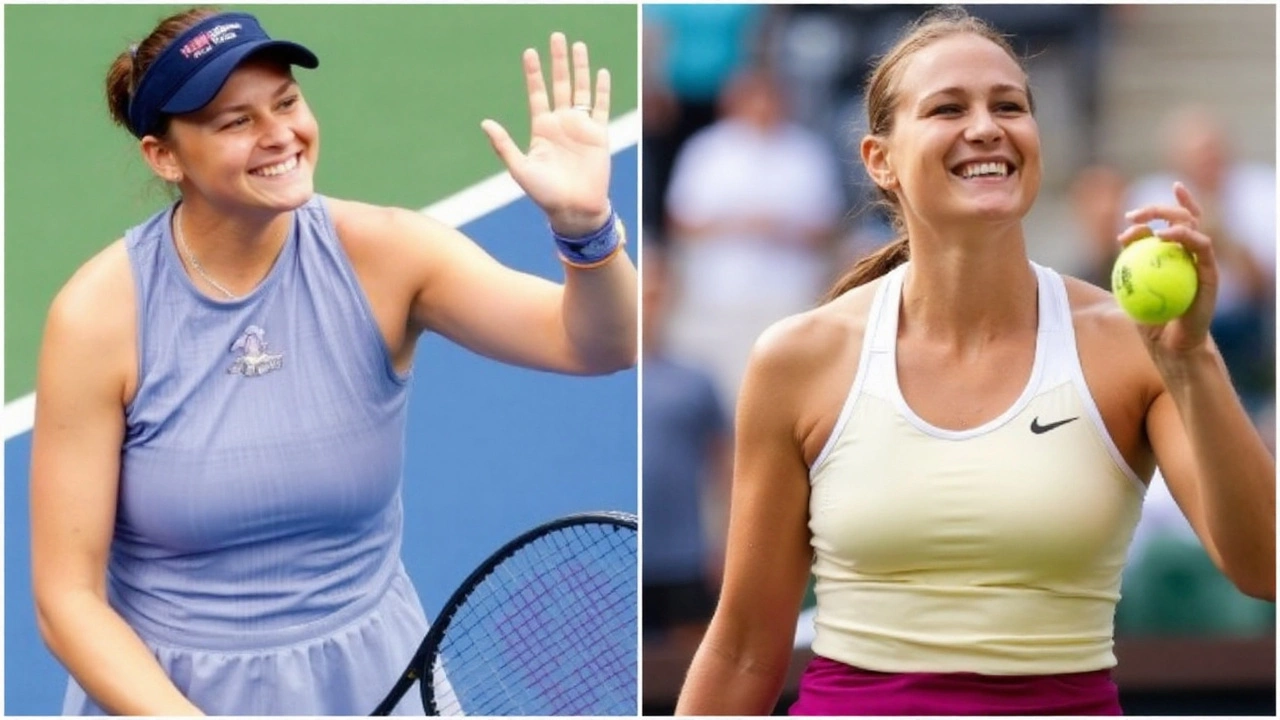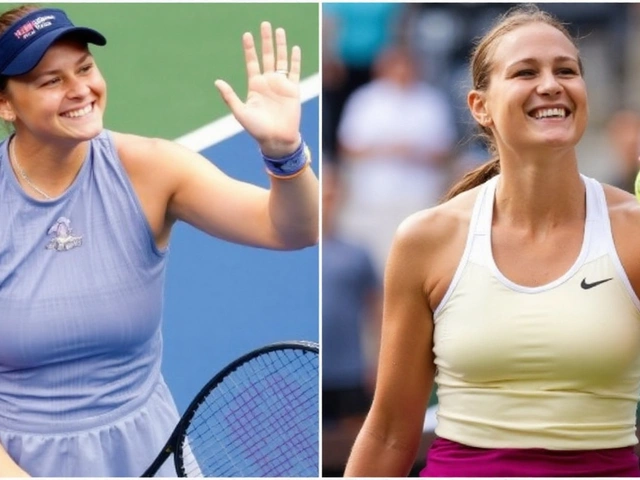US Open 2025 women’s final: Sabalenka holds firm under the roof
Aryna Sabalenka kept her crown in New York, beating American Amanda Anisimova 6-3, 7-6 (3) to become the first woman since Serena Williams to win the US Open in back-to-back years. The world No. 1 handled the pressure, the noise, and a closed-roof night at Arthur Ashe Stadium to pull off a measured, ruthless defense of her title at the US Open 2025.
The stage felt different from the opening ball. Rain and rolling thunderstorms forced the roof to shut, turning the arena into a loud indoor cauldron with bright artificial lights and a heavy, fast ball. Around 24,000 fans filled Ashe, leaning into every rally and feeding an American hopeful who was playing her second Grand Slam final and her first at home. The conditions, though, cut both ways. The closed roof amplified Sabalenka’s pace and muted the elements, while the lighting created visibility issues that clearly bothered Anisimova on serve.
Sabalenka arrived with the form and the résumé. She was the defending champion, the tour’s dominant force on hard courts, and the player with the season’s most intimidating tiebreak record. Her camp has talked all year about building patience to go with her power, and it showed. She didn’t need to hit through walls on every point; she picked her moments and made Anisimova play one extra ball, trusting the scoreboard and her legs.
The first set set the tone. Sabalenka established early control with heavy returns, particularly into the body, and a steady first-serve rhythm that kept her ahead in most baseline exchanges. Anisimova tried to counter by taking the ball early and redirecting pace down the line, but the errors piled up when she was pushed off her contact point. Sabalenka’s balance stood out: 13 winners against 15 unforced errors by night’s end, a tidy line for a hitter known for blasting winners in bunches.
The second set brought the drama. Sabalenka twice grabbed a break and served for the match at 5-4, the crowd restless and sensing a final American push. At 30-all, she got a sitter overhead. Match point was there. She dumped it into the net. Arthur Ashe roared; Anisimova pumped her fist; and suddenly the set flipped. Anisimova broke back for 5-5, buying time and belief at the exact moment she needed both.
Yet this is where Sabalenka has grown. The miss didn’t spiral into a meltdown. She took a breath, reset on return, and went into the tiebreak with clear plans. From 1-1, she surged to 6-1 with a mix of deep, heavy backhands and well-spotted serves that jammed Anisimova on the backhand wing. The American saved two match points, but Sabalenka closed it 7-3 on the third chance, finishing with a controlled forehand that stayed inside the lines she had drawn for herself all night.
What separated them? Margins and conviction. Sabalenka’s power is the headline, but her patience was the story. She softened her targets when rallies stretched, aimed big only when her feet were set, and used height over the net to push Anisimova back before going for corners. On return, she picked the hips and body to take away the American’s flat first strike. Even when the rally tempo climbed, Sabalenka’s shot tolerance held. In the tight moments, that mattered more than speed off the strings.
The roof made the match feel faster. Indoors, Sabalenka’s serve jumped through the court and her first strike did more damage. Anisimova’s flat hitting can thrive in similar conditions, but the lighting became an extra opponent. She repeatedly looked uncomfortable on tosses and blocked returns, and several key points slipped when her timing went just a touch off. That’s not an excuse—she still forced a tiebreak when this could have ended at 6-3, 6-4—but it framed the narrow margins she was managing.
Anisimova leaves with more to build on than the score suggests. She showed real steel in breaking back at 4-5 and not letting the match go quietly. Her second Grand Slam final looked nothing like a first-timer’s panic. She held the baseline when she could, stepped inside the court to change direction, and trusted her backhand down the line to flip a few patterns. Against the tour’s top closer in tiebreaks this season, taking it to a breaker under a closed roof was a mark of how far her game and composure have come.
Sabalenka’s numbers told their own story. She didn’t chase highlight-reel totals. She managed them. The 13 winners and 15 unforced errors speak to shot selection, not just execution. And when the scoreboard demanded clarity—service games after breaks, start of a tiebreak—she landed first serves and hammered returns deep enough to draw short balls. Her season-long edge in breakers wasn’t an accident; it’s the product of cleaner targets and better point-building at 4-4, 5-5, and 6-6.
The win gives Sabalenka her fourth Grand Slam title, all on hard courts: two in Melbourne and now two in New York. It also cements a streak of majors in three straight seasons, something very few pull off in the WTA era. The historic note that will travel: she’s the first to defend the US Open women’s crown since Serena’s run more than a decade ago. We’ve seen dominant single fortnights in New York; we don’t often see a player own the place two Septembers in a row.
Rankings-wise, this result keeps Sabalenka comfortably at No. 1 heading into 2026 with a sizable cushion. She’s stacked points all year, but New York mattered most: the defense of a massive haul under pressure, and the message it sends to the field. With the season-ending finale still to come, she holds the inside lane for year-end honors and the narrative weight that comes with them.
Credit the teamwork behind it, too. Sabalenka’s camp has been open about the work on serve mechanics and return positioning. The serve looks less streaky, with a simpler toss and repeatable motion. On return, she stands a fraction closer and attacks through the middle more often before spreading the court. Small tweaks, big payoffs, especially indoors where clean contact is king.
For Anisimova, the positives are clear: a Grand Slam final in front of home fans, a full match of resilience, and proof that her flatter, early-taking style can hold up against the heaviest hitter on tour. The next step is making these matches longer for the opponent—adding a few safer rally patterns, stealing more cheap points behind first serves, and leaning into net looks when the baseline gets hot. The margins at this level are tight; tightening three or four points a set flips scorelines.
The crowd inside Ashe felt that tug-of-war all night. New York loves a brawler and a home hope, and Anisimova gave them both. But they also recognize a closer when they see one. Every time Sabalenka faced a scoreboard question, you could hear the hush before the serve and the pop after it landed. Championship tennis is consistently answering those questions the same way. She did.
Context matters, and this final drops into a WTA picture that’s been loud and crowded. Big hitters have had their weeks; counterpunchers, too. What separates the very top right now is clarity under pressure. Sabalenka’s tiebreak numbers this season, now meaningfully padded again, are a window into that. You can’t fake your way through 7-6s at this level. You build them, one dependable decision at a time.
As the tour turns toward the season-ending showpiece and then a short off-season, the takeaways are clean. Sabalenka’s hard-court blueprint travels. Indoors or outdoors, slow night or quick afternoon, she can win striking big and thinking pragmatically. Anisimova, meanwhile, has rekindled momentum and a blueprint of her own: take time away, commit to first-strike tennis, and ride the confidence from New York into the next big stages.
New York didn’t just crown a repeat champion. It laid out the standard for the coming months—power with patience, nerve when it tightens, and the ability to turn chaos into control inside the loudest stadium in tennis. On a wet September night with the roof sealed shut, Aryna Sabalenka did all of it again.
Tactics, pressure, and what it means from here
- Serve patterns: Sabalenka mixed body serves to cramp Anisimova’s backswing, then went wide on the ad side to open the backhand corner. The variation kept return games from settling into a rhythm.
- Return depth: By driving the first ball deep through the middle, Sabalenka forced neutral rallies instead of letting Anisimova step in and redirect. Neutral points tilted her way as exchanges lengthened.
- Shot tolerance: Sabalenka accepted longer rallies and played with a higher net clearance when out of position. That cut the error rate without blunting her power on the next ball.
- Indoors factor: The closed roof sped the court and sharpened first-strike tennis. It favored both, but the lighting clearly affected Anisimova’s toss and contact more, especially late in service games.
- Scoreboard poise: After the missed overhead at 5-4, Sabalenka’s reset into the tiebreak showed the difference between letting a moment define you and using it. She won the first five points of the breaker and never looked back.
Numbers don’t tell everything, but they underline the story. Sabalenka finished with a clean winners-to-errors balance and extended her season tiebreak dominance. Anisimova had spurts that pushed the match to the edge, particularly when she flattened her backhand down the line, but she couldn’t string enough of those points together against the best front-runner on tour.
History will log the basics—scoreline, trophy lift, a note about consecutive titles—but the memory from Ashe is simpler: a champion who played within herself and an American challenger who left everything out there. One held firm when it tipped. That’s what finals usually ask, and it’s what decided this one.





